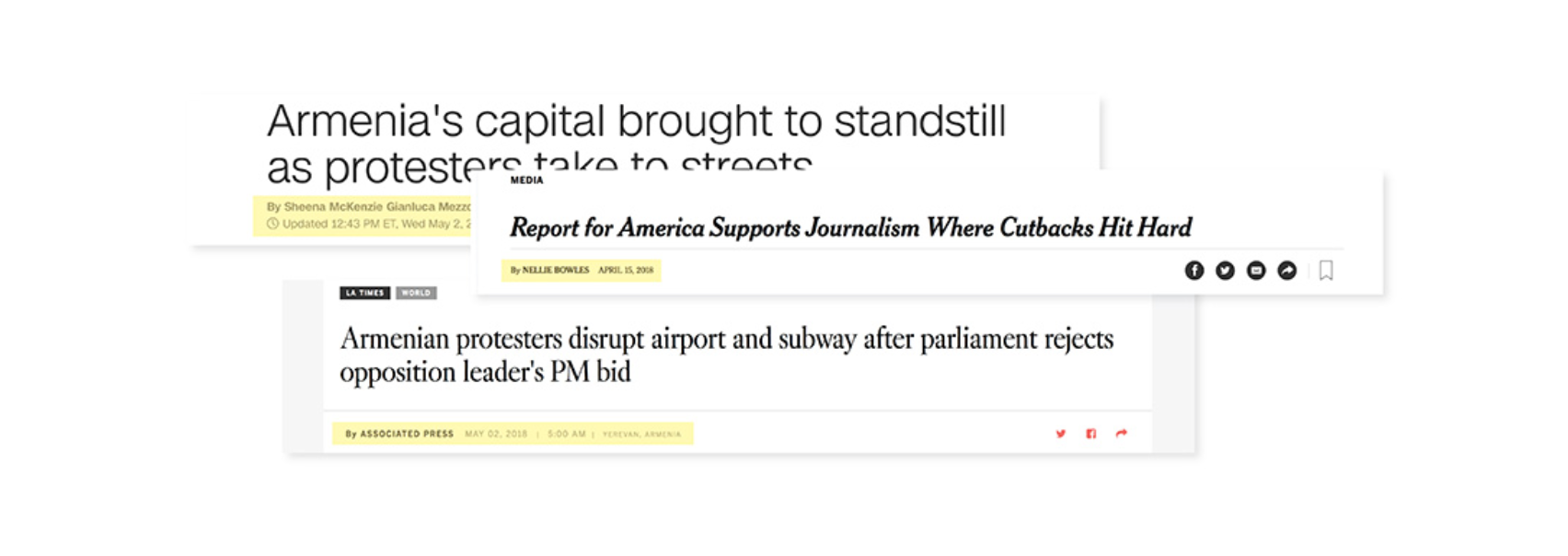Editing the Byline
2018A collaboration project with Izzi Sneider, a student from The New School's Journalism + Design program, to conceive, create, and design a prediction about future of journalism. By defining the role of being the primary designer and working with Izzi, the primary journalist, a webpage was created through a provided html/css template to explain our journalism problem and prototype solutions.
This collaboration was completed through conversations on Slack and sharing Google docs. Izzi and I shared our individual interests and found that we were both intrigued on tackling an ethical problem in journalism. Each week, we created a shared to-do list where individual tasks were assigned. Read our final article (below) and our proposed solutions mockups!
This collaboration was completed through conversations on Slack and sharing Google docs. Izzi and I shared our individual interests and found that we were both intrigued on tackling an ethical problem in journalism. Each week, we created a shared to-do list where individual tasks were assigned. Read our final article (below) and our proposed solutions mockups!
Editing the Byline
By Izzi Sneider and Ashley MinWho does the brunt of the work when reporting non-western stories and news?
One of the major problems being challenged of Western Journalism is the way news outlets report on non-western and non-white conflict and crises. Often times, White American journalists are sent to conflict zones without extensive knowledge of the culture, community, and political climate of said conflict/crisis zone, to combat this, foreign journalists are paired with a “fixer”, or local journalist who is can help make connections, translate, and contextualize events.
These fixers and local journalists are the backbone of “world coverage” yet rarely, if ever, receive credit in published pieces and virtually never see their name in the byline. Not only is this inaccurately depicting who is doing the grunt work and reporting, but it causes multiple different problems.
It perpetuates the false narrative that of the white reporter being necessary in explaining and understanding non-white, non-western conflict zones as well as leaves readers feeling a lack of connection between the journalist and them, leading to a distrust in the media as you are unable to put faces to the names and news outlets the reader is supposed to trust.
 Examples of what article bylines currently look like on CNN, NY Times, and LA Times.
Examples of what article bylines currently look like on CNN, NY Times, and LA Times.THE PROBLEM
In a world where marginalized people are finally able to speak up and be heard, new sources are starting to question and challenge long held journalistic practices and evaluate how people are affected by reportage. With that, the question of credit and how all journalists should be portrayed is being asked.Giving credit where credit is due is extremely important as it favors the general public's interpretation of the news and shapes how many readers view non-Western and non-White communities and cultures.
Even the most “liberal” news outlets are guilty of contributing to negative stereotyping by crediting a White, Western journalist as the only person that could explain why and how conflicts and crises are happening in non-Western places that are already viewed as being uneducated or unsophisticated by the general news reader.

The New York Times, for example, is one of the most highly respected news outlets. Still, they fail to credit fixers and feature local journalists in their publication, both online and in print.

While the New York Times provide some writers with their own bio pages, these pages only have an archive of their articles. Some of these bio pages don't even provide a picture of the journalist, or a bio at all.
SOLUTION
There are spaces in bylines and bio pages can be utilized more efficiently. Our redesign of the typical byline is simple, but incredibly effective.
BYLINES
Include globe icons with markers that indicate where each journalist is from to provide readers with a sense of location.
When users hover over a journalist's name, the globe icon would animate and rotate to their individual markers.
A short description about each journalist's contributions to the article.

BIO PAGES
Make each journalist's name an active link to their individual bio pages.
All journalists (local and non-local) would have their own page.
A picture of the journalist and the country the writer is reporting from would be added.
Below their bio, an archive of their works would be listed.
This system builds off of the strengths already existing in story formatting such as the byline’s visibility without intrusivity, its ability to keep a professional distance between reporter and reader that keeps personal attacks from disgruntled readers at bay, and the of course the fact that it does credit the writer.
 How these changes could be adapted on different news media designs.
How these changes could be adapted on different news media designs.